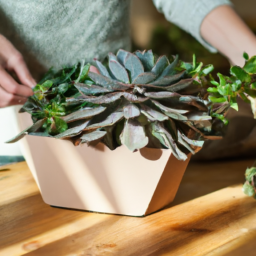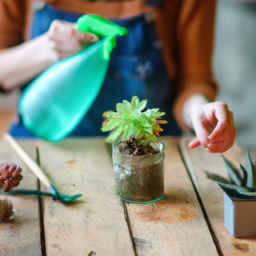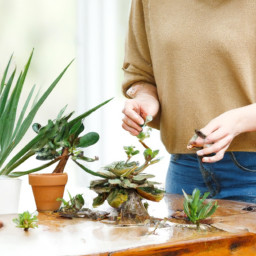
Hey there! Are you a proud owner of succulent plants, or are you considering adding these trendy little beauties to your indoor or outdoor space? If so, you’ve come to the right place. In this blog post, we’ll be diving into the wonderful world of caring for succulent plants. Whether you’re a beginner or a seasoned succulent enthusiast, we’ve got you covered with all the tips and tricks you need to keep your succulents thriving and looking their best. So, let’s get started and learn how to give these delightful plants the love and attention they deserve!
Understanding the Watering Needs of Succulent Plants
When it comes to caring for succulent plants, understanding their watering needs is crucial. Succulents are unique plants that have adapted to survive in arid environments by storing water in their leaves, stems, and roots. Their ability to retain water makes them low-maintenance and perfect for busy plant enthusiasts. However, proper watering techniques are still essential to ensure their health and longevity. In this guide, we will walk you through the step-by-step process of watering succulent plants.
1. Assessing the Watering Frequency
Before delving into the specifics of watering succulent plants, it’s important to understand that their watering needs vary depending on factors such as climate, season, and the type of succulent. While there is no one-size-fits-all approach, a general rule of thumb is to water your succulents thoroughly but infrequently.
During the growing season, which typically occurs in spring and summer, succulents require more frequent watering as they actively grow. However, during the dormant period in fall and winter, their watering needs decrease significantly. Be mindful of the signs your succulents give you; if their leaves appear plump and firm, it’s a good indication that they are well-hydrated. On the other hand, wrinkled or shriveled leaves may indicate dehydration.
Remember, it’s better to underwater than overwater succulents. Overwatering can lead to root rot and other issues, which can be fatal for these plants. Now that you have an idea about the watering frequency, let’s move on to the next step.
2. Watering Techniques for Succulent Plants
When it comes to watering succulent plants, the goal is to thoroughly saturate the soil and then allow it to dry out completely before watering again. This mimics the natural cycle of rainfall in arid regions. Follow these steps to ensure you’re watering your succulents correctly:
Step 1: Choose a well-draining potting mix specifically formulated for succulents. This type of soil allows excess water to flow out of the pot, preventing waterlogging.
Step 2: Place your succulent in a pot with drainage holes at the bottom. This ensures that any excess water can escape, preventing root rot.
Step 3: Water your succulent until you see water flowing out of the drainage holes. This indicates that the soil is thoroughly saturated.
Step 4: Allow the soil to dry out completely before watering again. Stick your finger into the soil up to the first knuckle; if it feels dry, it’s time to water your succulent.
Step 5: Avoid misting or spraying water on the leaves of succulent plants. This can lead to fungal diseases and damage the delicate foliage. Instead, focus on watering the soil directly.
Step 6: Adjust your watering frequency based on the specific needs of your succulent and the environmental conditions. As mentioned earlier, observe the appearance of the leaves and adjust accordingly.
3. Additional Tips for Watering Succulent Plants
Now that you have a solid understanding of the watering needs and techniques for succulent plants, here are a few additional tips to ensure their overall well-being:
Tip 1: Use a watering can or a narrow spout to direct the water flow directly to the soil. This helps prevent water from pooling on the leaves and causing damage.
Tip 2: Consider the climate and humidity levels in your area. If you live in a dry climate, you may need to water your succulents more frequently. Conversely, if you reside in a humid environment, reduce the watering frequency.
Tip 3: Avoid using cold water straight from the tap, especially during colder months. Instead, allow the water to reach room temperature before watering your succulents. Sudden temperature changes can shock the plants.
Tip 4: If you notice signs of overwatering, such as yellowing leaves, mushy stems, or a foul smell, take immediate action. Remove the affected plant from its pot, gently shake off excess soil, and allow it to dry out in a well-ventilated area. Once the roots have dried out, repot the succulent using fresh soil.
By following these step-by-step instructions and additional tips, you can ensure the proper care and watering of your succulent plants. Remember, each succulent is unique, so it’s important to observe and adjust your watering routine accordingly. With a little practice and attention, your succulents will thrive and bring beauty to your indoor or outdoor space.

Choosing the Right Soil Mix for Succulent Care
Succulents are unique plants that require special care to thrive. One crucial aspect of succulent care is choosing the right soil mix. The soil mix plays a vital role in providing the necessary nutrients, drainage, and aeration for these plants. In this article, we will guide you through the process of selecting the perfect soil mix for your succulents.
Understanding the Needs of Succulents
Before delving into the specifics of soil mix, it is essential to understand the needs of succulents. Succulents are known for their ability to store water in their leaves, stems, or roots. They have adapted to survive in arid environments with limited rainfall. Therefore, the soil mix for succulents should mimic the well-draining and sandy conditions of their natural habitats.
When it comes to succulent care, the soil mix should have excellent drainage to prevent waterlogged roots, which can lead to root rot. Additionally, it should provide sufficient aeration for the roots to breathe. The soil mix should also be nutrient-rich to support the growth and overall health of the succulents.
Components of a Good Succulent Soil Mix
A good succulent soil mix typically consists of three main components: organic matter, inorganic matter, and amendments. Let’s explore each component in detail:
1. Organic Matter: Organic matter helps retain moisture while still allowing for proper drainage. It also provides some nutrients to the plants. Common organic materials used in succulent soil mixes include peat moss, coconut coir, compost, and well-rotted manure.
2. Inorganic Matter: Inorganic matter, such as sand, perlite, or pumice, is crucial for improving drainage and preventing soil compaction. These materials create air pockets in the soil, allowing excess water to drain away quickly. They also help mimic the natural sandy conditions that succulents prefer.
3. Amendments: Amendments are optional but can be beneficial for enhancing the soil mix. Some common amendments include crushed granite, limestone, or charcoal. These amendments can provide additional drainage, adjust pH levels, or improve the overall structure of the soil mix.
Creating Your Own Succulent Soil Mix
Now that you understand the components of a good succulent soil mix, let’s dive into creating your own:
Step 1: Gather the Materials: Collect the necessary materials, including organic matter (such as peat moss or coconut coir), inorganic matter (like sand or perlite), and any optional amendments you wish to include.
Step 2: Determine the Ratios: The ideal ratio for a succulent soil mix is one part organic matter to two parts inorganic matter. For example, you could use one cup of peat moss and two cups of perlite. If you decide to add amendments, follow the recommended ratios provided by the manufacturer.
Step 3: Mix Thoroughly: In a large container or bucket, combine the organic matter, inorganic matter, and amendments (if using). Mix them thoroughly until well combined. This will ensure that the components are evenly distributed throughout the soil mix.
Step 4: Test the Drainage: Before potting your succulents, it’s essential to test the drainage of the soil mix. Take a small amount of the mix and moisten it slightly. Squeeze it in your hand and then release. If the mix crumbles easily and doesn’t hold too much moisture, it has good drainage.
Step 5: Potting Your Succulents: Once you are satisfied with the drainage, it’s time to pot your succulents. Fill the pots with the soil mix, leaving enough space for the roots. Gently place the succulents in the pots and cover the roots with additional soil mix. Press the soil gently to secure the plants.
Conclusion
Choosing the right soil mix is crucial for the care of your succulent plants. By understanding the needs of succulents and creating a suitable soil mix, you can provide the optimal growing conditions for these unique plants. Remember to prioritize excellent drainage, aeration, and nutrient-rich soil to ensure the health and longevity of your succulents.

Providing Adequate Sunlight for Healthy Succulent Growth
When it comes to caring for succulent plants, one of the most crucial factors for their overall health and growth is providing them with adequate sunlight. Succulents are naturally adapted to thrive in bright and sunny conditions, so it is essential to understand the importance of sunlight and how to ensure your succulents receive the right amount of it.
The Importance of Sunlight for Succulents
Succulents, known for their fleshy leaves and ability to store water, have evolved to survive in arid environments with intense sunlight. Sunlight is essential for their photosynthesis process, which enables them to convert light energy into chemical energy and produce their own food. Without sufficient sunlight, succulents may become weak, stretched, and lose their vibrant colors.
Furthermore, sunlight plays a crucial role in the growth and development of succulents. It helps them maintain their compact and sturdy form, promotes the production of essential nutrients, and enhances their overall resilience against pests and diseases. Therefore, providing adequate sunlight is vital for the long-term health and vitality of your succulent plants.
Understanding the Sunlight Requirements
While succulents thrive in bright light, it is important to note that not all succulents have the same sunlight requirements. Some succulents prefer direct, intense sunlight, while others thrive better in partial shade or indirect light. Understanding the specific sunlight requirements of your succulents is crucial to ensure optimal growth and prevent any damage caused by excessive or insufficient light.
Most succulents fall into one of three categories based on their sunlight preferences:
1. Full Sun Succulents: These succulents require at least six hours of direct sunlight every day. They can tolerate and thrive in intense sunlight without getting sunburned. Examples of full sun succulents include Echeveria, Sedum, and Agave.
2. Partial Sun Succulents: These succulents prefer a balance between direct sunlight and shade. They can tolerate a few hours of direct sunlight but generally require some protection during the hottest part of the day. Examples of partial sun succulents include Haworthia, Aloe, and Gasteria.
3. Shade-Loving Succulents: These succulents thrive in indirect or filtered light and are sensitive to direct sunlight. They require protection from intense sunlight to prevent sunburn and leaf damage. Examples of shade-loving succulents include Sansevieria, Zamioculcas, and Peperomia.
Providing Adequate Sunlight
To ensure your succulents receive adequate sunlight, follow these steps:
1. Observe and analyze the light conditions: Before placing your succulents, observe the light conditions in your desired location. Take note of the intensity and duration of sunlight throughout the day. This will help you determine the best spot for your succulents based on their sunlight preferences.
2. Position your succulents accordingly: Based on your observations, position your succulents in the appropriate location. Full sun succulents should be placed where they will receive direct sunlight for at least six hours a day. Partial sun succulents can be placed in areas with a balance of direct sunlight and shade. Shade-loving succulents should be positioned in areas with indirect or filtered light.
3. Rotate your succulents: Succulents tend to grow towards the direction of the light source. To ensure even growth and prevent your succulents from leaning or stretching towards one side, rotate them every few weeks. This will allow all sides of the plant to receive equal sunlight exposure.
4. Use protective measures: If you live in an area with intense sunlight or during the summer months when the sun is stronger, provide shade or use protective measures for your succulents. This can include using sheer curtains, shade cloths, or placing them under a patio or awning. Be cautious not to completely block out sunlight, as succulents still require light to thrive.
5. Monitor your succulents: Regularly monitor the health and appearance of your succulents to ensure they are receiving the right amount of sunlight. Signs of inadequate sunlight include pale or yellowing leaves, elongated stems, and a stretched or leggy appearance. If you notice these signs, adjust the lighting conditions accordingly.
By following these steps and providing adequate sunlight, you can ensure the healthy growth and vibrant appearance of your succulent plants. Remember to always consider the specific sunlight requirements of your succulents and make adjustments accordingly. With proper care and attention, your succulents will thrive and bring beauty to your indoor or outdoor space.
Summary Snapshot
Succulent plants have become increasingly popular in recent years due to their unique shapes and low-maintenance nature. These plants, which store water in their leaves and stems, are perfect for those who may not have the greenest thumbs but still want to enjoy the beauty of indoor plants. However, caring for succulents does require some attention and understanding of their specific needs.
First and foremost, succulents need plenty of sunlight to thrive. Place them near a sunny window or in a well-lit area of your home. While they can tolerate some shade, it’s important to avoid direct sunlight during the hottest hours of the day, as this can cause their leaves to burn. Additionally, succulents have shallow root systems and prefer well-draining soil. When watering, it’s crucial to strike a balance. Overwatering can lead to root rot, while underwatering can cause the plants to wither. Aim for a watering schedule that allows the soil to dry out between waterings, and always check the moisture level before reaching for the watering can. By following these simple guidelines, you can ensure your succulent plants stay healthy and vibrant for years to come.
Here are this week’s Top Questions and Answers
Q1: How often should I water my succulent plants?
A1: The frequency of watering your succulent plants depends on various factors such as the type of succulent, the climate you live in, and the potting mix used. As a general rule, it’s best to water your succulents thoroughly when the soil is completely dry. This usually translates to watering them every 1-2 weeks during the growing season and reducing the frequency during winter when they enter dormancy.
Q2: What type of soil is best for succulent plants?
A2: Succulents thrive in well-draining soil that allows excess water to flow out easily. It’s recommended to use a special succulent or cactus potting mix, which typically consists of a combination of regular potting soil, coarse sand, and perlite. This mixture helps prevent waterlogging and promotes healthy root growth.
Q3: How much sunlight do succulents need?
A3: Succulents generally require bright, indirect sunlight to thrive. They love being in sunny spots, but intense, direct sunlight for prolonged periods can scorch their leaves. It’s best to place your succulents near a window where they can receive a few hours of direct sunlight in the morning or evening, while being protected from the harsh midday sun.
Q4: Do succulents need fertilizers?
A4: Succulents are relatively low-maintenance plants and can survive without regular fertilization. However, providing them with a balanced, diluted fertilizer during the growing season can promote healthier growth and vibrant colors. It’s recommended to use a fertilizer specifically formulated for succulents and cacti, following the instructions on the packaging for proper application.
Q5: How do I propagate succulent plants?
A5: Propagating succulents can be a fun and rewarding process. One common method is through leaf propagation, where you gently remove a healthy leaf from the parent plant and allow it to dry for a few days until a callus forms. Then, you can place the leaf on top of well-draining soil, mist it occasionally, and wait for roots and new growth to appear. Another method is stem cutting, where you cut a healthy stem and let it dry for a few days before planting it in soil. With patience and proper care, you can easily propagate new succulent plants.

James Wong is a renowned ethnobotanist, plant scientist, and local television presenter. With a passion for demystifying plant science, he is known for translating complex botanical concepts into practical advice for everyday plant enthusiasts. James’s expertise spans from traditional gardening to cutting-edge plant technologies, making his insights accessible and informative.


